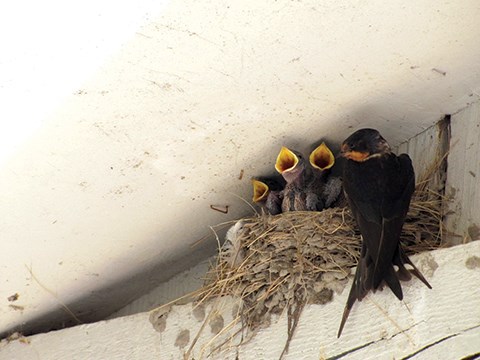How do they do it?
The swallow parents using the nest-box in my backyard work at least 16 hours a day to raise their young.
At 5 a.m. they are already out and about gathering insects to feed to their nestlings, and from what I can see they keep going non-stop all through the day until about 9 p.m. And they do this every day.
The reference books say that it takes between 16 and 24 days for the young to fledge. It’s hard to imagine working for 16 hours a day for 16 consecutive days without a break. Their dedication to raising their brood is truly impressive.
I keep my distance from the nest-box so as not to disturb them, but I can hear the nestlings cheeping away most of the time. I always know when a parent has returned because the cheeping becomes so much more intense. And even from a distance, I can see one of the baby swallows sometimes peeking out of the nest-box.
It makes me wonder about sibling rivalry. As ornithologists tell us, the largest nestling often deprives its siblings of food by positioning itself optimally. I do hope it is different babies that I am seeing and that they will all fledge successfully.
The next generation of deer is also growing fast right now. The “Bambis” are out and about, learning the rules of life, sometimes the hard way. The other day, a mother doe and her spotted fawn were standing in the road as we pulled out of our driveway. The mum jumped off the road into the undergrowth right away.
The baby also jumped, but it headed straight towards my (stationary) car. It knew from its mum that it needed to flee, but it hadn’t yet learned to get off the road immediately. This is a good warning to us all that these babies, who are typically just six weeks old when they venture out, have much to learn.
This is one of the themes of the novel that inspired the 1942 Walt Disney movie Bambi. The novel, called Bambi, A Life In the Woods (well, that’s the English translation of the German, obviously) was written in 1923 by Austrian Felix Salten. The novel traces the life of Bambi, a male roe deer, from his birth through childhood to maturity.
The novel, which has been described as one of the first environmental novels ever published, focuses on Bambi’s experiences including losing his mother and finding a mate.
Throughout the book, Bambi is taught lessons by a powerful older stag, who near the end of the book reveals that he is Bambi’s father. Most of the lessons that he learns relate to the dangers posed by human hunters in the forest.
Happily, Bowen Island’s Bambis do not face a huge risk from hunters, although the broken arrow shaft I found on a deer trail through my yard this spring indicates that hunting does happen here.
Our fawns and deer face a much greater risk from cars and trucks travelling at or faster than the speed limit. Think of it this way: Mule deer (the deer we have on Bowen) can run up to 40 kilometres per hour.
They have evolved that way over centuries. That speed is designed to allow them to escape from most of their natural predators. But cars and trucks are not natural predators. They are exceedingly unnatural.
Our Bowen Island speed limit of 40 kilometres per hour should give a deer some chance to get out of the way, but if you are exceeding the speed limit, the deer will have no chance, and you will have a dead or damaged deer on the road or through your windshield.
So, please, while the next generation of deer are learning to be vehicle-savvy, drive slowly. And it’s good to remember that deer move around in family groups at this time of the year.
When you see one deer, there are usually others nearby.



